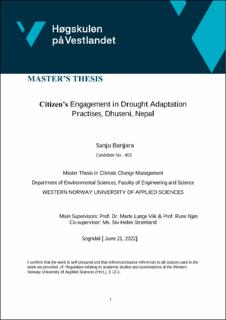| dc.description.abstract | Nepal is one of the most vulnerable countries in terms of climate change. Climate change is impacting the livelihood of people in all the sectors in Nepal especially in the rural areas in the mid hills. The mid hills regions have a difficult and uneven topography for agriculture and the extreme drought situations have created serious issues in agriculture. Rural populations in mid hills are engaged in agriculture as the major source of livelihood in the rural areas. Therefore, the study was conducted in the rural mid hill village of Nepal (i.e., Dhuseni). The study had the following research questions to find out: 1) the adaptation activities carried out in Dhuseni, 2) the factors that were determining the adaptation actions and practises and 3) the challenges for implementation status of local adaptation policy and plan of action (LAPA).
A questionnaire survey was carried out where altogether 50 respondents participated in the survey, along with 5 key informant interviews. From the survey, it was evident that villagers had been facing an extreme drought situation recently and they had adapted to the situations as per their capacity such as using drought resistance crops, building water canals, migration, etc.
Adaptation practises were found to be a gendered process in the village; factors such as gender, education and income and public support were found to be determining the adaptation actions/practises in the village. LAPA is a local adaptation plan and policy formulated in the village, which is a guiding document for climate change adaptation in in climate vulnerable communities. Even though LAPA plans and policies extraordinary are considered extraordinary with its inclusive and participatory approaches; it was found that the villagers were not given access to all the adaptation services as mentioned in LAPA.
Due to political influence, limited capacity of the local government, LAPA implementation was found to be ineffective in the village. Although the villagers are adapting to their capacity, the adaptation practises could become more effective with active involvement and support from local government. Therefore, the involvement of citizen in climate adaptation action/practises plays important roles in the rural villages for the effective and transformative climate action. This study found that the engagement of citizen is not sufficiently taken into consideration in LAPA implementation. | en_US |

